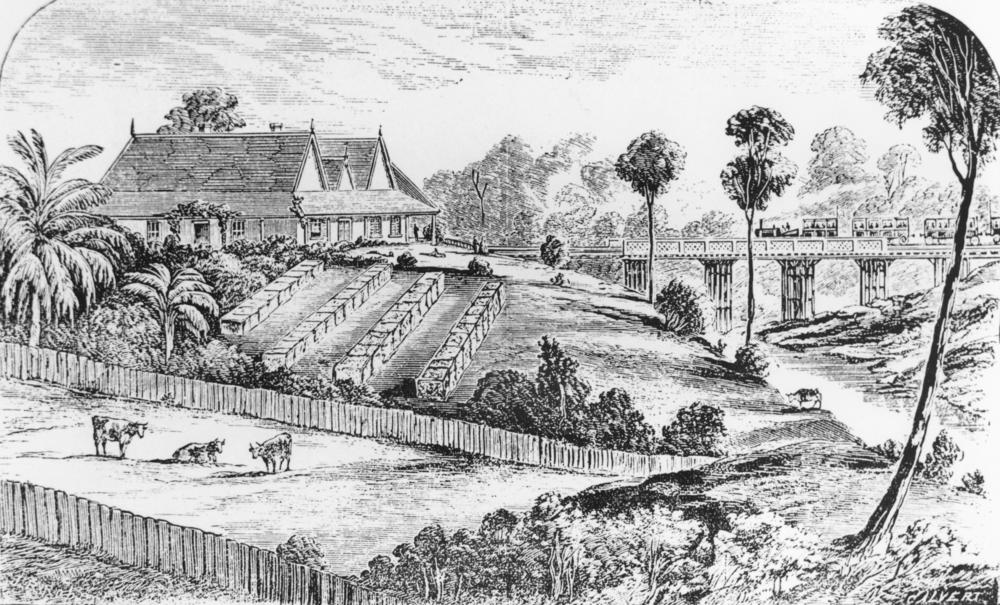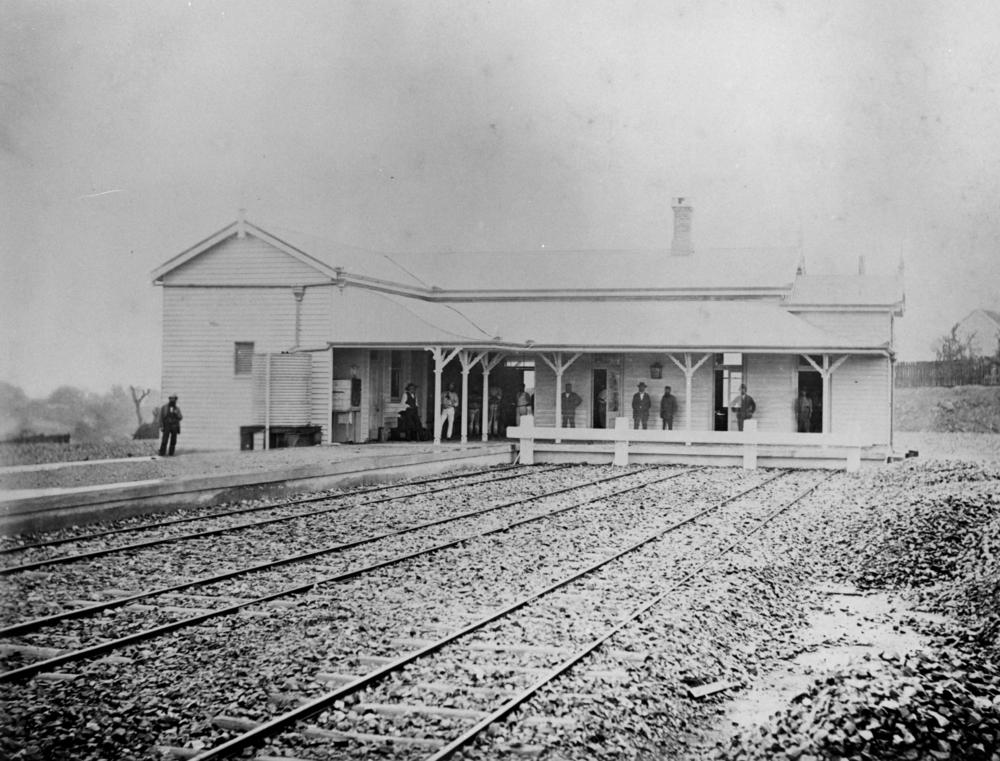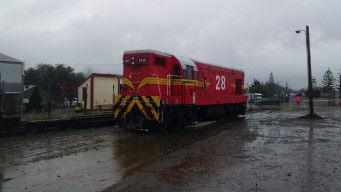|
Queensland Railways 1400 Class
The 1400 class was a class of diesel locomotive built by Clyde Engineering, Granville for Queensland Railways between 1955 and 1957. History In 1955, Clyde Engineering demonstrated an Electro-Motive Diesel G12 locomotive to Queensland Railways who purchased it along with two other demonstrators under construction, and also placed an order for a further 10. The first three were initially numbered 1230-1232, before being reclassified as the 1400 class. When built, they were tested on standard gauge with Bo-Bo bogies, and received their A1A-A1A bogies upon arrival in Queensland. The demonstrators differ from the production series in placement of the number boxes and marker lights on the ends of the unit. They are similar in appearance to the NZR DA class, first-series Victorian Railways T class and the Kowloon-Canton Railway Class 50 (later the CFCLA TL class), and mainly operated in South East Queensland. The first was withdrawn in December 1986. Two have been preserved: [...More Info...] [...Related Items...] OR: [Wikipedia] [Google] [Baidu] |
Queensland Railways 1450 Class
The 1450 class was a class of diesel locomotive built by Clyde Engineering, Granville for Queensland Railways in 1957-1958. History The 1450 class was an evolution of the 1400 class, being built as a Co-Co instead of an A1A-A1A. This increased the weight by but improved the tractive effort. They mainly operated in South East Queensland. To accommodate the Co-Co bogies, the unit was lengthened on both ends. The Sarmiento Railway in Argentina operated similarly-lengthened G12s, officially designated the GR12. The South American units differed from the Australian ones in having only the No. 1 end hood lengthened. The first was withdrawn in December 1986. Three have been preserved by Queensland Rail's Heritage Division, and are stored at Workshops Rail Museum, North Ipswich North Ipswich is a suburb of Ipswich in the City of Ipswich, Queensland, Australia. In the , North Ipswich had a population of 4,515 people. Raymonds Hill is a neighbourhood within the suburb of North I ... [...More Info...] [...Related Items...] OR: [Wikipedia] [Google] [Baidu] |
South East Queensland
South East Queensland (SEQ) is a bio-geographical, metropolitan, political and administrative region of the state of Queensland in Australia, with a population of approximately 3.8 million people out of the state's population of 5.1 million. The area covered by South East Queensland varies, depending on the definition of the region, though it tends to include Queensland's three largest cities: the capital city Brisbane; the Gold Coast; and the Sunshine Coast. Its most common use is for political purposes, and covers and incorporates 11 local government areas, extending from Noosa in the north to the Gold Coast and New South Wales border in the south (some sources include Tweed Heads, New South Wales which is contiguous as an urban area with Brisbane/Gold Coast), and west to Toowoomba (which is simultaneously considered part of the Darling Downs region). South East Queensland was the first part of Queensland to be settled and explored by Europeans. Settlements initially aro ... [...More Info...] [...Related Items...] OR: [Wikipedia] [Google] [Baidu] |
Railway Locomotives Introduced In 1955
Rail transport (also known as train transport) is a means of transport that transfers passengers and goods on wheeled vehicles running on rails, which are incorporated in tracks. In contrast to road transport, where the vehicles run on a prepared flat surface, rail vehicles (rolling stock) are directionally guided by the tracks on which they run. Tracks usually consist of steel rails, installed on sleepers (ties) set in ballast, on which the rolling stock, usually fitted with metal wheels, moves. Other variations are also possible, such as "slab track", in which the rails are fastened to a concrete foundation resting on a prepared subsurface. Rolling stock in a rail transport system generally encounters lower frictional resistance than rubber-tyred road vehicles, so passenger and freight cars (carriages and wagons) can be coupled into longer trains. The operation is carried out by a railway company, providing transport between train stations or freight customer facilit ... [...More Info...] [...Related Items...] OR: [Wikipedia] [Google] [Baidu] |
Queensland Rail Locomotives
) , nickname = Sunshine State , image_map = Queensland in Australia.svg , map_caption = Location of Queensland in Australia , subdivision_type = Country , subdivision_name = Australia , established_title = Before federation , established_date = Colony of Queensland , established_title2 = Separation from New South Wales , established_date2 = 6 June 1859 , established_title3 = Federation , established_date3 = 1 January 1901 , named_for = Queen Victoria , demonym = , capital = Brisbane , largest_city = capital , coordinates = , admin_center_type = Administration , admin_center = 77 local government areas , leader_title1 = Monarch , leader_name1 = Charles III , leader_title2 = Governor , leader_name2 = Jeannette Young , leader_title3 = Premier , leader_name3 = Annastacia Palaszczuk ( ALP) , legislature = Parliament of Queensland , judiciary = Supreme Court of Queensland , national_representation = Parliament of Australia , national_representation_type1 = ... [...More Info...] [...Related Items...] OR: [Wikipedia] [Google] [Baidu] |
Diesel Locomotives Of Queensland
Diesel may refer to: * Diesel engine, an internal combustion engine where ignition is caused by compression * Diesel fuel, a liquid fuel used in diesel engines * Diesel locomotive, a railway locomotive in which the prime mover is a diesel engine Arts and entertainment * Diesel (band), a Dutch pop/rock group * ''Diesel'' (1942 film), a German film about Rudolf Diesel * Diesel (2022 film), an Indian Tamil language thriller film * Diesel (game engine), a computer gaming technology * Diesel, a former name of Brazilian rock band Udora People Surname * Nathanael Diesel (1692–1745), Danish composer, violinist and lutenist * Vin Diesel (Mark Sinclair, born 1967), American actor, producer and director * Rudolf Diesel (1858-1913), German inventor and mechanical engineer Nickname or ring name * Diesel (musician) (Mark Lizotte, born 1966), American-Australian rock singer-songwriter * Kevin Nash (born 1959) ring name and gimmick for American professional wrestler Kevin Nash while p ... [...More Info...] [...Related Items...] OR: [Wikipedia] [Google] [Baidu] |
Clyde Engineering Locomotives
Clyde may refer to: People * Clyde (given name) * Clyde (surname) Places For townships see also Clyde Township Australia * Clyde, New South Wales * Clyde, Victoria * Clyde River, New South Wales Canada * Clyde, Alberta * Clyde, Ontario, a town in North Dumfries, Regional Municipality of Waterloo, Ontario * Clyde Township, a geographic township in the municipality of Dysart et al, Ontario * Clyde River, Nunavut New Zealand * Clyde, New Zealand ** Clyde Dam Scotland * Clydeside * River Clyde * Firth of Clyde United States * Clyde, California, a CDP in Contra Costa County * Clyde, Georgia * Clyde Township, Whiteside County, Illinois * Clyde, Iowa * Clyde, Kansas * Clyde, Michigan * Clyde Township, Allegan County, Michigan * Clyde Township, St. Clair County, Michigan * Clyde, New Jersey * Clyde, New York * Clyde, North Carolina * Clyde, North Dakota * Clyde, Ohio ** Clyde cancer cluster * Clyde, Pennsylvania * Clyde, South Carolina * Clyde, Texas * Clyde River (Vermont) The ... [...More Info...] [...Related Items...] OR: [Wikipedia] [Google] [Baidu] |
A1A-A1A Locomotives
The AAR wheel arrangement system is a method of classifying locomotive (or unit) wheel arrangements that was developed by the Association of American Railroads. Essentially a simplification of the European UIC classification, it is widely used in North America to describe diesel and electric locomotives (including third-rail electric locomotives). It is not used for steam locomotives, which use the Whyte notation instead. The AAR system counts axles instead of wheels. Letters refer to powered axles, and numbers to unpowered (or idler) axles. "A" refers to one powered axle, "B" to two powered axles in a row, "C" to three powered axles in a row, and "D" to four powered axles in a row. "1" refers to one idler axle, and "2" to two idler axles in a row. A dash ("–") separates trucks or wheel assemblies. A plus sign ("+") refers to articulation, either by connecting bogies with span bolsters or by connecting individual locomotives via solid drawbars instead of couplers. 1A-A1 "1A-A1" ... [...More Info...] [...Related Items...] OR: [Wikipedia] [Google] [Baidu] |
Ipswich, Queensland
Ipswich () is a city in South East Queensland, Australia. Situated on the Bremer River, it is approximately west of the Brisbane central business district. The city is renowned for its architectural, natural and cultural heritage. Ipswich preserves and operates from many of its historical buildings, with more than 6000 heritage-listed sites and over 500 parks. Ipswich began in 1827 as a mining settlement. History Early history Ipswich according to The Queenslander (Brisbane, Qld,: 1866-1939), Thursday 18 January 1934, Page 13 was tribally known as Coodjirar meaning place of the Red Stemmed Gum Tree in the Yugararpul language. Jagara (also known as Jagera, Yagara, and Yuggara) and Yugarabul (also known as Ugarapul and Yuggerabul) are Australian Aboriginal languages of South-East Queensland. There is some uncertainty over the status of Jagara as a language, dialect or perhaps a group or clan within the local government boundaries of Ipswich City Council, Lockyer Regional C ... [...More Info...] [...Related Items...] OR: [Wikipedia] [Google] [Baidu] |
Mackay, Queensland
} Mackay () is a city in the Mackay Region on the eastern or Coral Sea coast of Queensland, Australia. It is located about north of Brisbane, on the Pioneer River. Mackay is described as being in either Central Queensland or North Queensland, as these regions are not precisely defined. More generally, the area is known as the Mackay–Whitsunday Region. Mackay is nicknamed the sugar capital of Australia because its region produces more than a third of Australia's sugar. Name The city was named after John Mackay. In 1860, he was the leader of an expedition into the Pioneer Valley. Initially Mackay proposed to name the river Mackay River after his father George Mackay. Thomas Henry Fitzgerald surveyed the township and proposed it was called Alexandra after Princess Alexandra of Denmark, who married Prince Edward (later King Edward VII). However, in 1862 the river was renamed to be the Pioneer River, after in which Queensland Governor George Bowen travelled to the area, and t ... [...More Info...] [...Related Items...] OR: [Wikipedia] [Google] [Baidu] |
Victorian Railways T Class
The T class are a class of diesel locomotives built by Clyde Engineering, Granville for the Victorian Railways between 1955 and 1968. History In July 1954, the Victorian Railways placed an order with Clyde Engineering for 25 (later extended to 27) diesel electric Electro-Motive Diesel G8 locomotives to partially dieselise country branch lines.1st Order (27 locos): T320-T346 & T413 (1 loco) Mark Bau's VR website In June 1959, the first of an additional ten entered service. Although mechanically similar to the first batch, they differed by having a cab raised above the hood line. Mark Bau's VR website A further ten entered service from Dece ... [...More Info...] [...Related Items...] OR: [Wikipedia] [Google] [Baidu] |
Gympie Railway Station
Gympie railway station is an Australian heritage-listed former railway station in Gympie, Queensland, on the North Coast railway line, Queensland, North Coast line. It was the primary railway station serving Gympie from 1881 until 1989. Original railway station After the discovery of gold in October 1867 by James Nash (prospector), James Nash in Gympie, the requirement of a railway line linked to a port became apparent. In 1877, the Government of Queensland, Queensland Government approved the construction of three railways to connect mining towns to their principal ports: Townsville to Charters Towers; Bundaberg to Mount Perry, Queensland, Mount Perry; and Maryborough, Queensland, Maryborough to Gympie. The station buildings at Gympie and Maryborough were positioned at the Terminal train station#Terminus, terminus of the track line, marking the railway's dead end status. The line opened on 6 August 1881. Within a year of the line opening, Gympie representatives began lobbying ... [...More Info...] [...Related Items...] OR: [Wikipedia] [Google] [Baidu] |
New Zealand DA Class Locomotive
The New Zealand DA class locomotive were a class of diesel-electric mainline locomotives operated on the New Zealand railway system between 1955 and 1989. Consisting of 146 locomotives, it was the most numerous class to ever operate in New Zealand, with five more than the AB class steam locomotive. The class were A1A-A1A versions of the Electro-Motive Diesel G12 model, with the design altered slightly to run on New Zealand's rail system, and fit the small loading gauge. They were introduced between 1955 and 1967 in three phases and were the first class of diesel locomotives to seriously displace steam traction. Between 1978 and 1983, 85 locomotives were rebuilt as the DC class, of which some are still in use. All but one of the remainder were withdrawn by 1989, with six preserved. The last locomotive was refitted for shunting duties and was rebuilt as DAR 517. Introduction The DA class have their origins in the post World War II period. Like most nations New Zealand's dom ... [...More Info...] [...Related Items...] OR: [Wikipedia] [Google] [Baidu] |






